Cultivating a Hydroponic Garden in Your Apartment
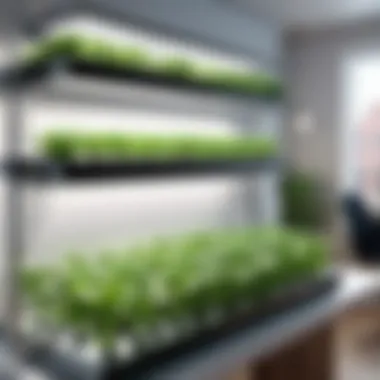
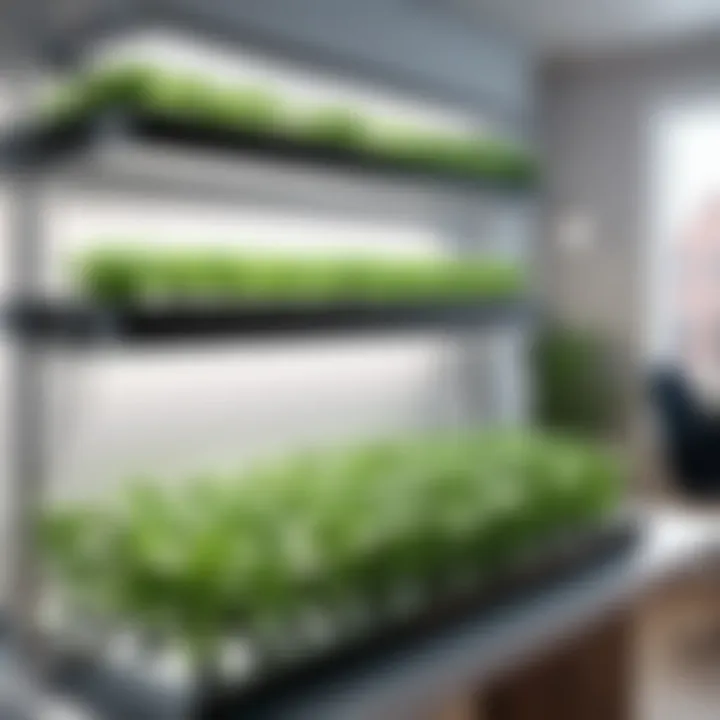
Intro
Creating a hydroponic garden in an apartment merges sustainability with convenience. Hydroponics, the method of growing plants without soil, has become increasingly essential for urban dwellers. This practice not only provides fresh produce but also maximizes limited space in an apartment.
In this article, we will explore the principles behind hydroponics along with practical guidance on establishing your own garden within your living space. Different systems will be analyzed, leading to thoughtful plant selection that can flourish in a hydroponic environment.
Emphasizing environmental control and maintenance, we aim to furnish you with the necessary knowledge for nurturing your plants from seedling to harvest. This approach to gardening is suitable for both beginners and seasoned gardeners. Here are some of the key aspects this article will delve into:
- Hydroponic systems suitable for apartments.
- Plant varieties that thrive in hydroponics.
- Maintenance practices for healthy growth.
This journey into hydroponics not only enhances gardening skills but also fosters a connection to food cultivation even when living in a high-rise setting. Let’s dive deeper into these topics, providing you with detailed insights and actionable steps to transform your apartment into a green haven.
Understanding Hydroponics
Understanding hydroponics is essential for anyone looking to establish a garden in an apartment. This practice allows you to grow plants without soil, using nutrient-rich water instead. The importance of hydroponics lies in its ability to maximize space and resources. In urban settings, where space is at a premium, hydroponics offers an innovative solution to growing fresh produce indoors. This method not only serves as an alternative for those with limited outdoor space but also reflects a growing trend towards sustainable living and urban agriculture.
What is Hydroponics?
Hydroponics is a method of growing plants in a water-based, nutrient-rich solution. Instead of traditional soil, plants receive essential nutrients directly through their roots submerged in this solution. This results in faster plant growth and can yield more produce in a smaller area. Hydroponics can be mixed with various systems, including nutrient film techniques and deep water culture. The effectiveness of these systems varies based on specific needs, lighting, and plant types.
The core idea is simple: by supplying nutrients directly to plants’ roots, growers enhance the efficiency of nutrient uptake. This method can result in healthier plants and shorter growth cycles. Hydroponics also allows precise control over pH levels and nutrient concentrations, which can lead to improved crop quality.
History and Evolution of Hydroponic Systems
The origins of hydroponics trace back to ancient civilizations. The Hanging Gardens of Babylon are often cited as one of the earliest examples of soil-less cultivation. However, hydroponics as we know it began to evolve in the 20th century. Research conducted by scientists like Dr. William Frederick Gericke in the 1930s laid the foundation for modern hydroponic methods.
Over the decades, various systems have emerged, showcasing the flexibility and potential of hydroponic gardening. Techniques have expanded from simple nutrient solutions to complex systems integrating technology, such as automated nutrient delivery and environmental monitoring.
Currently, the rise of interest in sustainable practices continues to fuel advancements in hydroponics. Innovations now emphasize efficiency and conservation, aligning with modern urban lifestyles. As a result, hydroponics has become more accessible, revolutionizing how we think about gardening indoors. Familiarity with hydroponics sets the stage for successful implementation in apartment settings.
Benefits of Hydroponic Gardening
Hydroponic gardening offers numerous advantages that make it an attractive option for urban dwellers looking to grow their own food. Understanding these benefits is crucial for anyone considering this method of gardening. Not only does hydroponics provide increased yield in a compact space, it also improves water usage efficiency and reduces exposure to pests. Each of these elements plays an important role in promoting sustainable and effective gardening practices, especially in city environments where traditional gardening may be limited or impractical.
Space Efficiency
In urban settings, space can be a significant constraint. Hydroponic gardening uses less space compared to traditional soil-based gardening. This is largely due to the vertical planting options available. Growers can utilize vertical hydroponic systems to maximize their available area. These systems allow for layers of plants stacked on top of each other, effectively using vertical space that would otherwise go underutilized.
The compact nature of hydroponic gardens makes them ideal for apartments with limited floor space. You can even set up a hydroponic garden in a small corner of your kitchen or on a balcony. The ability to cultivate multiple plants in different growth stages within a confined space means that you can enjoy a continuous supply of fresh produce.
Water Conservation
Water conservation is another major advantage of hydroponic gardening. Traditional soil gardening often wastes significant amounts of water due to evaporation and runoff. In contrast, hydroponic systems recirculate water, which reduces waste. Studies suggest that hydroponic systems can use up to 90% less water than conventional gardening methods. This conservation is particularly significant in urban regions where water resources may be limited or expensive.
Furthermore, the nutrient-rich water in hydroponics is reused, allowing plants to absorb what they need effectively. This targeted delivery of water and nutrients contributes to faster growth rates and higher yields.
Pest Control
Pest control is often a major concern for gardeners. However, hydroponic systems generally have fewer pest problems than traditional gardens. Since hydroponic gardens are often indoors or in controlled environments, they are less susceptible to outdoor pests and diseases. The absence of soil reduces the chances of soil-borne pests and pathogens.
When pest problems do arise, they tend to be easier to manage in a hydroponic system. Growers can quickly identify and isolate affected plants, preventing a wider outbreak. Additionally, the controlled environment allows for integrated pest management techniques to be more easily implemented, resulting in healthier plants.
The benefits of hydroponics in urban environments are clear: smaller space requirement, efficient water use, and effective pest management.
Suitable Hydroponic Systems for Apartments
Establishing a hydroponic garden in an apartment involves selecting a suitable hydroponic system. This choice is crucial because the system influences space utilization, maintenance, and the overall success of the garden. Different systems offer unique advantages and pose specific challenges, which require thoughtful consideration based on your living conditions and gardening goals.
Here are some essential factors to keep in mind when selecting a hydroponic system for an apartment:
- Space: Your available space dictates the type of system you can implement. Some systems are compact, while others require more room for optimal growth.
- Maintenance: Depending on your schedule, some systems may be easier to manage than others. Systems that require frequent maintenance might not be ideal for those with busy lifestyles.
- Plant Type: Different plants thrive better in specific systems, so understanding their needs is key.
- Budget: Setting up a hydroponic garden can vary in cost. Choosing a system that fits your budget while meeting your needs is important.
With these considerations in mind, let's explore various hydroponic systems suitable for apartment gardening.
Deep Water Culture (DWC)
Deep Water Culture is one of the simplest and most popular hydroponic systems. In this method, plants grow with their roots submerged in nutrient-rich water, allowing them to access both nutrients and oxygen. An air pump connected to an air stone provides oxygenation for the plant roots.
Benefits of DWC include:
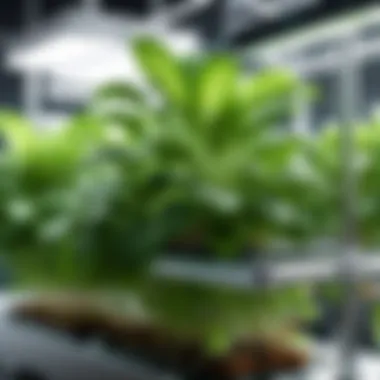
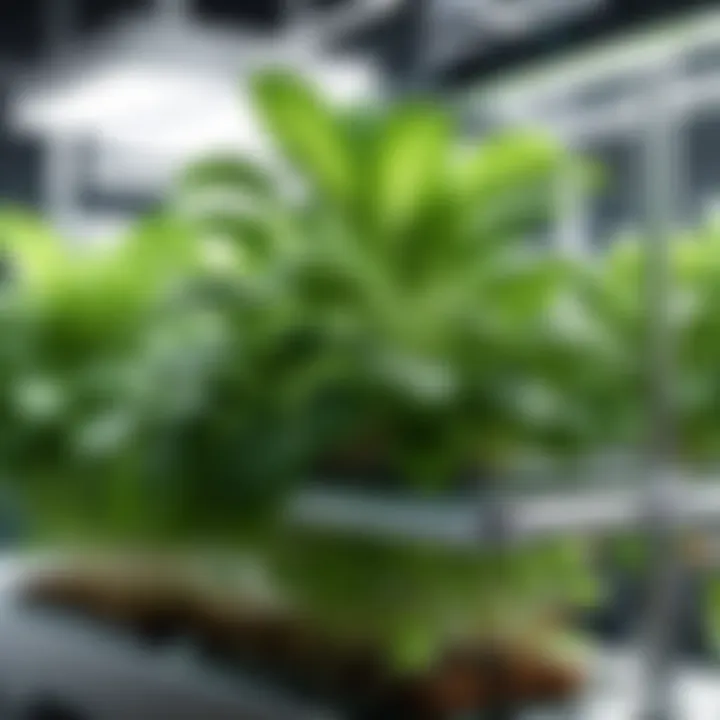
- Fast Growth: Plants often grow more rapidly in DWC due to high nutrient availability.
- Space Saving: The system can be compact, making it suitable for limited areas.
- Minimal Equipment: Basic setups require fewer components than other methods, reducing complexity.
However, there are risks with DWC. Algal growth can occur, especially with inadequate light control. Monitoring water temperature and nutrient levels is crucial.
Nutrient Film Technique (NFT)
The Nutrient Film Technique is a method where a thin film of nutrient solution continuously flows over the roots of plants. The roots absorb the necessary nutrients and oxygen while the rest of the solution is recirculated back into a reservoir.
NFT has several notable advantages:
- Efficient Use of Nutrients: Since the solution is recirculated, there's less waste.
- Oxygen Availability: Roots are exposed to air, preventing water logging and promoting healthy root systems.
On the downside, NFT requires careful monitoring; if the pump fails, plants could quickly suffer from nutrient deprivation. Getting the right setup may require more initial planning and investment compared to simpler systems.
Ebb and Flow Systems
Ebb and Flow systems utilize a flooding mechanism to distribute nutrient solution to plant roots, which are placed in a growing medium. A timer controls the flooding intervals, allowing the roots to absorb nutrients and oxygen intermittently.
Key benefits of Ebb and Flow include:
- Automated Watering: This system allows for automation, reducing manual labor.
- Flexibility in Plant Choices: It supports a wide range of plant types, from herbs to larger vegetables.
However, Ebb and Flow systems necessitate more components, such as pumps and timers. There can also be fluctuations in moisture levels if not regularly monitored.
Wicking Systems
Wicking systems are among the simplest hydroponic methods. They operate on a capillary action principle where a wick draws nutrient-rich water from a reservoir into a growing medium, where the plant roots absorb the necessary nutrients.
Advantages of wicking systems include:
- Low Maintenance: They are easier to manage and require less frequent monitoring compared to other systems.
- Cost-Effective: With simple construction and fewer components, this system can be budget-friendly.
Nevertheless, wicking systems may not adequately support larger plants that demand more nutrients. Moreover, their effectiveness hinges on the right media and wick materials to optimize nutrient transfer.
In summary, choosing a suitable hydroponic system is foundational for a successful garden. Each method has its pros and cons that need to align with individual circumstances.
Setting Up Your Hydroponic Garden
Creating a hydroponic garden in an apartment involves careful planning and an understanding of various factors. Setting up your hydroponic system properly lays the foundation for successful plant growth. A well-established system can yield fresh produce and enhance your living environment.
One of the first considerations is selecting the right location. This decision impacts the overall effectiveness of your garden. Light, temperature, and accessibility are all crucial elements that should not be overlooked. You want a space that allows for adequate light exposure and is easily accessible for maintenance tasks.
Another key aspect is ensuring you have the essential equipment and supplies. Without the right tools, your gardening efforts may face significant challenges. Below we explore the most critical components you need for an effective setup.
Choosing the Right Location
Location, location, location. This adage rings true for hydroponic gardening as well. Your choice of space will significantly affect your garden's performance. Look for a spot with ample light, either natural or through artificial grow lights. It should be warm enough since most plants thrive in a temperature range of about 65 to 75 degrees Fahrenheit.
Accessibility is also important. You will be interacting with your system regularly, so place it where you can reach it easily. This ensures that you can monitor growth, check nutrient levels, and perform any necessary maintenance.
Essential Equipment and Supplies
A successful hydroponic garden requires specific equipment and supplies. Each component plays a distinct role in ensuring that plants grow healthy and strong.
Growth Containers
Growth containers are fundamental to any hydroponic system. These containers hold the plants and the nutrient solution that delivers essential minerals. Their main characteristic is size and depth, which should be suitable for the types of plants you wish to cultivate.
The large surface area allows for optimal root development, promoting vigorous growth. A popular choice for many gardeners is net pots. They are lightweight, durable, and enable efficient water circulation. However, be careful with integration as poor material can lead to root issues.
Nutrient Solutions
Nutrient solutions are vital for hydroponic gardens. They provide all the necessary elements plants need to grow. These solutions typically contain macronutrients such as nitrogen, phosphorus, and potassium, as well as micronutrients like iron and manganese.
One key advantage of nutrient solutions is their targeted formulation. They cater to the specific needs of your plants and allow for measurable growth. However, improper mixing can cause nutrient imbalances, harming the plants. Knowing the correct ratios is essential.
Water Pumps
Water pumps circulate the nutrient solution throughout the system. They are essential for ensuring that all plants receive adequate moisture and nutrients. Choosing a reliable pump is crucial for maintaining the health of your garden.
A beneficial feature of water pumps is their ability to operate continuously or intermittently, depending on the system you choose. However, ensure that you select a pump with the correct flow rate; too much or too little can harm plant health.
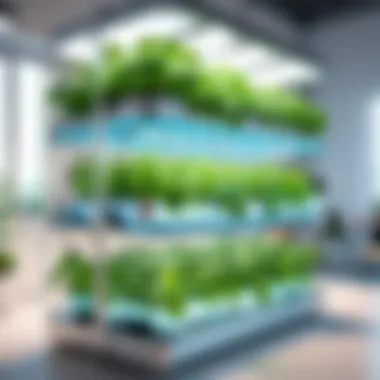
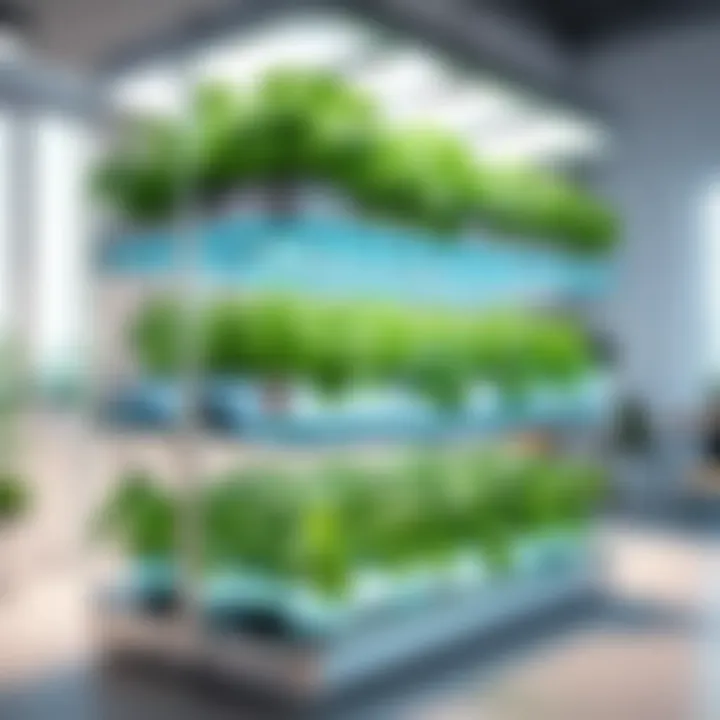
Air Pumps
Air pumps are also integral to hydroponic systems. They introduce oxygen into the nutrient solution, which is critical for root respiration. Plants require oxygen for various metabolic processes, so having an effective air pump can enhance growth rates significantly.
These pumps are relatively easy to install and can fit into most setups. Investing in a quiet pump can reduce noise, ensuring a peaceful living environment. However, not all pumps are created equal; pay attention to their energy efficiency as it impacts your overall running costs.
In summary, setting up your hydroponic garden requires a thoughtful approach to both location and equipment. Each component must work in harmony to create an environment conducive to plant growth. Proper planning can lead to a fruitful gardening experience, even in the limited space of an apartment.
Selecting the Right Plants
Selecting the right plants for your hydroponic garden is essential for achieving success. The choice of plants not only influences growth rates, but it also affects the sustainability of your setup. Some plants are better suited to hydroponic methods than others. It's important to consider factors such as growth cycles, light requirements, and nutrient needs specific to your plants. Proper selection ensures that your garden yields a bountiful harvest while maximizing your limited space effectively.
Best Plants for Hydroponics
Lettuce and Greens
Lettuce and other leafy greens are often the top choice for hydroponic systems. These plants have a relatively short growth cycle, allowing for multiple harvests throughout the year. They thrive in nutrient-rich water, which is a key element of hydroponics. The crisp texture and fresh taste of lettuce make it a popular choice for many gardeners. Additionally, lettuce varieties such as romaine and butterhead are tolerant of varying pH levels, making them quite adaptable. The main drawback is that they can be susceptible to pests if not monitored.
Herbs
Herbs are another ideal option for hydroponic gardening. They require less space and can be grown closer together, maximizing yield in small areas. Popular choices such as basil, mint, and cilantro are not only flavorful but also have a high market value. Their aromatic qualities attract beneficial insects, which can contribute to a healthier garden environment. The main consideration is that some herbs might require specific light conditions to flourish, so monitoring light exposure is important.
Tomatoes
Tomatoes are well-known for their robust flavor and versatility in cooking. They can thrive in hydroponic systems, but they require more space and support due to their growth habits. Tomatoes grow well in environments where they can receive ample light and nutrients. The main advantage is their high yield, which can be especially rewarding for urban gardeners. However, they can be prone to diseases if humidity levels are not properly managed, so attention to detail is key.
Peppers
Peppers, including bell and chili varieties, are a great choice for hydroponics as they adapt well to controlled environments. Their vibrant colors and shapes add visual appeal to any garden. Peppers tend to have a longer growth cycle compared to lettuce, but they can produce a significant harvest. They also require a stable temperature range for optimal growth. One of the challenges with peppers is their sensitivity to nutrient concentrations; therefore, regular monitoring is essential to prevent nutrient burn.
Growth Cycles and Requirements
Understanding the growth cycles and requirements of chosen plants is crucial in hydroponic gardening. Each plant has specific conditions it thrives under, including optimal temperature, light exposure, and nutrient levels. This knowledge allows gardeners to set up their systems more effectively for maximum yield. For instance, leafy greens tend to grow rapidly and can be harvested within four to six weeks, while tomatoes may take several months.
Knowing how to balance environmental factors is vital. Adjusting pH levels, maintaining nutrient solutions, and ensuring adequate light promotes healthy growth and prevents diseases. With careful consideration of these aspects, hydroponic gardening in an apartment can turn into a rewarding hobby.
Maintaining Your Hydroponic System
Maintaining your hydroponic system is a critical aspect of successful gardening in an apartment. Unlike traditional soil-based gardening, hydroponics relies entirely on nutrient-rich water to support plant growth. Any imbalance in this system can lead to poor plant health and low yields. Understanding the components that contribute to maintaining an effective hydroponic garden will ensure that plants thrive, maximizing the potential benefits of urban gardening.
Nutrient Management
Nutrient management is central to hydroponics. Plants require a variety of nutrients for optimal growth, which are typically delivered through water. In a hydroponic garden, the nutrients must be managed carefully.
It is important to monitor the concentration of nutrient solutions regularly. Over-fertilization can lead to nutrient burn, while under-fertilization can stunt growth. A common practice is to use a nutrient solution specifically designed for hydroponics, which includes micronutrients and macronutrients like nitrogen, phosphorus, and potassium.
“Regular checks help ensure that nutrition levels stay within optimal ranges.”
In practical terms, maintaining proper nutrient levels involves adjusting the solution based on the growth stage of the plants. Young seedlings, for example, require different nutrient levels compared to mature plants. Using complete nutrient kits simplifies this process for beginners.
pH Monitoring
Monitoring pH levels is equally important in hydroponics. The pH scale measures how acidic or alkaline the nutrient solution is, and this can significantly impact nutrient availability. Most plants thrive in a pH range of 5.5 to 6.5.
To maintain suitable pH levels:
- Invest in a calibrated pH meter.
- Regularly test the nutrient solution.
- Adjust the pH using pH up or down solutions as needed.
Small changes can affect plant uptake of essential nutrients, promoting healthier growth and better yields. If the pH strays too far from the optimal range, plants may show signs of nutrient deficiencies or toxicities, impacting their overall health.
Light Requirements
Providing adequate light is another crucial factor for maintaining a hydroponic garden. Plants need sufficient light to perform photosynthesis, and in an apartment setting, natural light may be insufficient.
When choosing the right lighting system, consider:
- LED Grow Lights: These are energy-efficient and emit the correct spectrum for plant growth. They can be adjusted for the height of the plants and tend to run cooler than other types.
- Fluorescent Lights: Often more affordable, they work well for growing herbs and leafy greens. However, they may need to be replaced more frequently than LEDs.
Light should ideally be provided for about 12-16 hours per day. Timers can automate the light schedule, ensuring consistent lighting periods. Proper light exposure not only assists plant growth but also assists in maintaining the general health of plants within the hydroponic system.
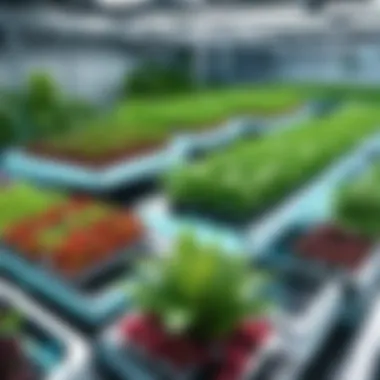
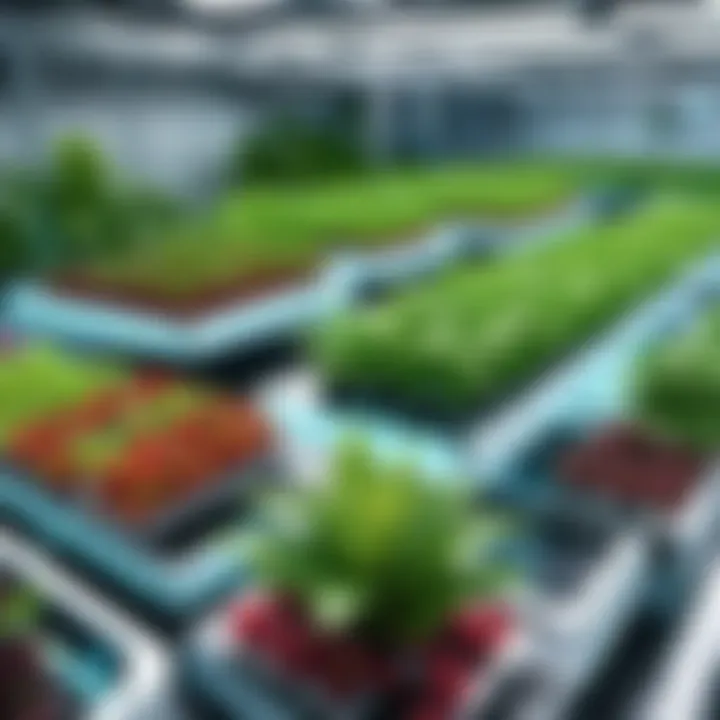
By focusing on nutrient management, pH monitoring, and light requirements, you can create a robust environment for your plants. This diligent maintenance ensures that a hydroponic garden remains productive and flourishing inside your apartment.
Common Challenges and Solutions
Establishing a hydroponic garden in an apartment is not without its hurdles. Understanding these common challenges is crucial for any enthusiast aiming for a successful garden. By identifying these issues early, gardeners can mitigate potential setbacks. The importance of addressing challenges lies in ensuring both the health of the plants and the overall effectiveness of the hydroponic system. Below, we discuss two prevalent issues that can arise: algal growth and diseases or pests.
Algal Growth
Algal blooms can be a frequent problem in hydroponic systems. They occur when light is exposed to nutrient-rich water for prolonged periods. Algae thrive in these conditions, potentially leading to various negative outcomes. Uncontrolled algal growth can deplete oxygen levels in the water, limiting the resources available to your plants. Furthermore, it can block light from reaching plant roots, inhibiting growth.
To manage this issue, consider implementing the following strategies:
- Light Control: Use opaque containers to minimize light exposure to the nutrient solution.
- Regular Cleaning: Maintain cleanliness in your system, as debris and organic matter can provide a food source for algae.
- UV Sterilizers: These devices can help by killing algae present in the water.
- Beneficial Microorganisms: Some microorganisms can outcompete algae for nutrients, thereby controlling its growth.
By being proactive about algal growth, one can maintain a healthy hydroponic environment and support plant health effectively.
Diseases and Pests
Hydroponic gardens are not exempt from diseases or pest infestations. The closed environment, while beneficial for plant growth, can also facilitate the spread of pathogens and pests. Common issues include fungal infections and infestations by aphids or whiteflies. These can adversely affect plant health, leading to reduced yields or, in severe cases, plant loss.
Several measures exist to prevent and manage such challenges:
- Regular Inspection: Frequently check your plants to spot early signs of pests or diseases.
- Proper Hygiene: Keep your growing environment clean, including tools and equipment, to lower contamination risk.
- Integrated Pest Management (IPM): Use a holistic approach to concerns, such as introducing beneficial insects or using organic pesticides.
- Disease Resistance: Select plants that possess innate resistance to common diseases.
These strategies underscore the importance of observation and active management in maintaining a thriving hydroponic garden in an apartment.
"Addressing challenges in hydroponics is critical for ensuring your plants thrive in small spaces."
Understanding these challenges and their solutions helps create a sustainable hydroponic garden. Careful management of algae and pests will lead to healthier plants and a more rewarding gardening experience.
Innovative Approaches in Hydroponic Gardening
Innovative approaches in hydroponic gardening are vital to maximizing space and improving plant growth efficiency, especially in an urban setting. As more city dwellers seek sustainable methods of food production, the integration of technology and creative designs has become increasingly important. These innovative methods not only address space limitations but also enhance yield, reduce resource consumption, and promote a more sustainable lifestyle.
Two significant innovative approaches worth discussing are vertical hydroponic systems and automated hydroponic systems. Both deliver unique advantages and cater to different gardening preferences and conditions.
Vertical Hydroponic Systems
Vertical hydroponic systems are designed to utilize vertical space efficiently, making them perfect for apartments. These systems stack plants vertically in rows or layers, maximizing the area available for growth. This method is particularly advantageous for cities where ground space is limited but vertical space is ample.
The benefits of vertical hydroponic systems include:
- Increased yield: By utilizing vertical space, gardeners can produce a higher volume of plants in the same footprint.
- Better light distribution: With stacked layers, plants receive even lighting, which can improve photosynthesis.
- Efficient water usage: These systems often employ a recirculating water system, which reduces waste and conserves resources.
However, there are some considerations to keep in mind when setting up a vertical hydroponic system. It is essential to ensure proper light distribution and airflow throughout the stacked plants. Moreover, the structure must be robust enough to support the weight of the plants and the nutrient solution.
Automated Hydroponic Systems
Automated hydroponic systems represent a leap forward in convenience and efficiency. With advances in technology, these systems can control various environmental factors like nutrient delivery, pH levels, and even lighting. Such automation can significantly reduce the hands-on maintenance required, making hydroponic gardening more accessible to individuals with busy lifestyles.
Key advantages of automated systems include:
- Consistency: Automation ensures that plants receive consistent care, reducing the risk of human error.
- Time savings: Gardeners can spend less time managing their systems and more time enjoying the fruits of their labor.
- Remote monitoring: Many systems allow users to monitor conditions remotely through smartphone applications, providing real-time data on plant health and system performance.
Nevertheless, automated systems can involve a higher initial investment. It is also important to understand how to troubleshoot technical issues to avoid potential failures in the system.
Innovative hydroponic gardening offers solutions designed for modern urban lifestyles, blending efficiency with sustainability. Understanding and adopting these methods can be a rewarding experience for any urban gardener.
The End and Future of Urban Hydroponics
The growth of urban hydroponics represents a significant shift in how we perceive food production in constrained environments. Urban areas face challenges including limited space for traditional gardening and the necessity for sustainable practices. Hydroponics emerges as a compelling solution, capable of transforming these barriers into opportunities.
This shift is not just about growing food; it is about rethinking the very nature of urban agriculture. Hydroponic systems can utilize less land while producing higher yields compared to conventional methods. This leads to more efficient use of urban spaces and helps in reducing food miles, therefore lowering carbon footprints associated with food transport.
Moreover, urban hydroponics promotes the concept of local food sovereignty. As people grow their own foods, they gain control over what they consume and how it is produced. This contributes to a potential decrease in dependence on commercial agricultural systems, which can be vulnerable to climate change and market fluctuations.
Sustainability and Urban Agriculture
Sustainability is at the core of hydroponic gardening in urban environments. Hydroponics significantly reduces water usage, using up to 90% less than traditional farming methods. The closed-loop systems recirculate water and nutrients efficiently.
Considerations that come with sustainability in urban hydroponics include:
- Energy Efficiency: Using LED grow lights and energy-efficient pumps can help reduce power consumption.
- Waste Minimization: Systems can be designed to incorporate waste recycling, such as composting organic material or using waste heat from indoor appliances.
- Community Engagement: Urban hydroponics projects can foster community ties, allowing neighbors to share knowledge and resources.
This approach also requires addressing economic considerations. Start-up costs can be higher for hydroponic systems compared to soil-based gardening. Still, the long-term investment often pays off with increased crop output and reduced resource consumption.
As urban hydroponics continues to evolve, it poses intriguing questions for future innovations. Will we see the integration of smart technology, sensors and automation systems becoming commonplace? How will regulatory frameworks adapt to accommodate this growing trend? The answers to these questions could shape the future of food production in urban environments significantly.







